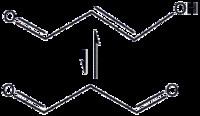Abbreviations MDA Molar mass 72.0636 g/mol | Formula C3H4O2 Appearance Needle-like solid | |
 | ||
Related alkenals | ||
Malondialdehyde (MDA) is the organic compound with the formula CH2(CHO)2. The structure of this species is more complex than this formula suggests. This reactive species occurs naturally and is a marker for oxidative stress.
Contents
Structure and synthesis
Malondialdehyde mainly exists in the enol form:
CH2(CHO)2 → HOCH=CH-CHOIn organic solvents, the cis-isomer is favored, whereas in water the trans-isomer predominates.
Malondialdehyde is a highly reactive compound that is not typically observed in pure form. In the laboratory it can be generated in situ by hydrolysis of 1,1,3,3-tetramethoxypropane, which is commercially available. It is easily deprotonated to give the sodium salt of the enolate (m.p. 245 °C).
Malondialdehyde results from lipid peroxidation of polyunsaturated fatty acids. It is a prominent product in Thromboxane A2 synthesis wherein cyclooxygenase 1 or cycloxygenase 2 metabolizes arachidonic acid to prostaglandin H2 by platelets and a wide array of other cell types and tissues. This product is further metabolized by Thromboxane synthase to Thromboxane A2, 12-Hydroxyheptadecatrienoic acid, and malonyldialdehyde. Alternatively, it may rearrange non-enzymatically to a mixture of 8-cis and 8-trans isomers of 12-hydroxyeicosaheptaenoic acid plus malonyldialdehyde (see 12-Hydroxyheptadecatrienoic acid). The degree of lipid peroxidation can be estimated by the amount of malondialdehyde in tissues.
Biochemistry
Reactive oxygen species degrade polyunsaturated lipids, forming malondialdehyde. This compound is a reactive aldehyde and is one of the many reactive electrophile species that cause toxic stress in cells and form covalent protein adducts referred to as advanced lipoxidation end-products (ALE), in analogy to advanced glycation end-products (AGE). The production of this aldehyde is used as a biomarker to measure the level of oxidative stress in an organism.
Malondialdehyde reacts with deoxyadenosine and deoxyguanosine in DNA, forming DNA adducts, the primary one being M1G, which is mutagenic. The guanidine group of arginine residues condense with malondialdehyde to give 2-aminopyrimidines.
Human ALDH1A1 aldehyde dehydrogenase is capable of oxidizing malondialdehyde.
Analysis
Malondialdehyde and other thiobarbituric reactive substances (TBARS) condense with two equivalents of thiobarbituric acid to give a fluorescent red derivative that can be assayed spectrophotometrically. 1-Methyl-2-phenylindole is an alternative more selective reagent.
Hazards and pathology
Malondialdehyde is reactive and potentially mutagenic. It has been found in heated edible oils such as sunflower and palm oils.
Corneas of patients suffering from keratoconus and bullous keratopathy have increased levels of malondialdehyde, according to one study. MDA also can be found in tissue sections of joints from patients with osteoarthritis.
